
Original Link: https://www.anandtech.com/show/1900
Intel Core Duo (Yonah) Performance Preview - Part II
by Anand Lal Shimpi on December 19, 2005 12:55 PM EST- Posted in
- CPUs
At the end of November, we finally did what we had been waiting to do for so long - provide the first performance benchmarks of Intel's Yonah processor, the dual core successor to the highly acclaimed Pentium M. However, our initial performance investigation was not without its flaws. Given the short amount of time that we had for benchmarking, we were forced to compare to older numbers from previous reviews, which unfortunately lacked updated gaming, encoding and 3D rendering tests.
Despite the shortcomings of the initial article, we did manage to get a good look at the performance that we could expect from Yonah. Mainly, it was a fairly strong successor to the single core Pentium M and even more impressive was that it offered performance equal to that of AMD's Athlon 64 X2 without an on-die memory controller. Many AnandTech readers kept our methods in check, however, by quickly pointing out that the Yonah vs. Athlon 64 X2 comparison wasn't exactly fair, as Yonah is equipped with a full 2MB of L2 cache, whereas the Athlon 64 X2 3800+ that we were comparing it against only had 512KB per processor, possibly painting Yonah in a better light.
So for this follow-up, we've done two important things. For starters, we've updated the benchmark suite considerably, including modern day games and a few professional-level applications hopefully to get a better perspective on Yonah's performance. We've also included an Athlon 64 X2 running at 2.0GHz, but with each core having a full 1MB L2 cache, making the Yonah vs. X2 comparison as close to even as possible (not mentioning the fact that AMD has twice the advantage in this round, with both a larger L1 cache and an on-die memory controller, but it should make things interesting).
We won't be revisiting the issue of power consumption, as we already did that at the end of our last article, but needless to say, Yonah is the most efficient dual core processor that we've tested to date. Granted that it does have the advantage of being on Intel's 65nm process whereas the Athlon 64 X2 is still based on AMD's 90nm process, but given that AMD is around a year away from transitioning to 65nm, it is an advantage that Intel has the right to enjoy.
What about Clock Speeds?
Whereas the Pentium 4's extremely deep pipeline made clock-for-clock comparisons to the Athlon 64 virtually meaningless, the Pentium M and Yonah processors feature far shorter pipelines akin to AMD's architecture.
The Athlon 64 features a 12-stage integer pipeline, and while Intel has never specifically disclosed the length of Yonah's pipeline, they have made two important statements: it is longer than the Pentium III's 10-stage integer pipeline, and shorter than Conroe/Merom's 14-stage pipeline. Given the relatively tight range, Yonah's pipeline can pretty much be considered to be very similar to AMD's Athlon 64, give or take a stage of the pipeline.
The net result is that we can draw some valid conclusions based on comparisons of Yonah to the Athlon 64 X2 at similar clock speeds.
But our Yonah sample ran at 2.0GHz, which ends up being the speed of the slowest Athlon 64 X2 that is currently available: the 3800+. The highest end Athlon 64 X2s currently run at 2.4GHz, with high speeds just around the corner. So the question isn't just how competitive Yonah is at 2.0GHz, but rather, how high can Yonah go? Unfortunately, our test platform wouldn't allow us to overclock our chip very far, but thankfully, we have access to a decent amount of Intel's future roadmaps, so we can at least see what's going to happen to Yonah over the next year.
While Yonah will make its debut at a maximum speed of 2.16GHz, it will actually only receive a single speed bump before Merom's release at the end of the year. That means that we'll see a 2.33GHz Yonah after the middle of the year, but we'll have to turn to Merom to get any higher clock speeds.
Looking back to our initial articles on the Pentium M's architecture, you'll remember that one of the important aspects of its design is that all critical paths in the chip were slowed down to meet a maximum clock target. This means that Intel set a clock target for the CPU and made sure that the chip ran at that speed or below, and did not optimize any paths that would have allowed the CPU to run higher. Instead, the Pentium M team depended on the manufacturing folks to give them additional clock speed headroom by providing smaller manufacturing processes every 2 years. In other words, the Pentium M was never designed for high clock speeds, which is why it debuted at 1.5GHz and still has not even reached 2.33GHz today.
Intel's next-generation microarchitecture hopes to change that approach ever so slightly by introducing a longer pipeline into the equation, but on a much more conservative basis than the Pentium 4 did just 5 years ago. Conroe (desktop), Merom (mobile) and Woodcrest (server) will feature a 14-stage integer pipeline, which will allow for higher clock speeds than what Yonah could pull through. We would expect a debut at a minimum of 2.4GHz and probably at least one speed grade higher. Learning from their mistakes with the Pentium 4, Intel will balance the reduction in efficiency of a deeper pipeline with a wider 4-issue core (vs. the current 3-issue core used in Yonah).
So it looks like Intel's plan for 65nm is to rely on their deeper pipelined processors (Conroe/Merom/Woodcrest) for higher clock speed, with Yonah falling below the 2.5GHz mark. And based on what we've seen in the first article, a 2.33GHz Yonah would be competitive with an Athlon 64 X2 4600+, but definitely not outpacing it. This does bode well for Intel's next-generation processors, especially on the desktop with Conroe.
If the move to a 4-issue core is able to balance out the negative impact of a deeper pipeline (which admittedly it may or may not do in all cases), a higher clock speed desktop part should be very good competition for AMD's offerings. Although based on what we've seen thus far, we would be surprised if Conroe vs. Athlon 64 was a blow-out in favor of either manufacturer; more and more, it is looking like Conroe will simply bring Intel up to par with AMD, ahead in some areas, behind in others, and with the lower power advantage as long as AMD is still at 90nm.
Why the X2 and why not Turion?
One of the other questions that we were asked a lot after the first article was why we insisted on comparing a mobile Yonah processor to a desktop Athlon 64 X2, and not an AMD Turion 64. Our reasoning was obvious to some, but we felt it made sense to present it more clearly here:
- As much as Yonah is a mobile processor, it is a great indicator of the performance of Intel's future desktop processors based on the Conroe core. AMD has already stated that beyond moving to Socket-M2 and some minor updates, there will be no significant architectural changes to the Athlon 64 line next year. In other words, we know for the most part how AMD's going to be performing next year, but we have no clue how Intel will towards the end of 2006; Yonah helps us fill in the blanks.
- AMD will have a dual core Turion based mobile processor out sometime in 2006. However, it will be based on AMD's Socket-M2 platform, meaning that it will include DDR2 support. Given that we don't know exactly how DDR2 is going to impact the Athlon 64's performance, we couldn't accurately simulate the performance of AMD's upcoming dual core Turion. Comparing a dual-core Yonah to AMD's single-core Turion also wouldn't be too valid a comparison either.
It's called the Core Duo
When Yonah first started appearing on roadmaps, we knew it as Jonah, which then starting being written as Yonah. Eventually, Intel confirmed its existence and we had always assumed that it would continue to use the name Pentium M. However, given the great importance of the launch of Intel's first dual-core, low power, notebook processor, it shouldn't be much of a surprise that Intel has a new name in store for it. As you've probably already heard, Yonah will receive the marketing name "Core" with the words "Duo" or "Solo" following it depending on whether it is the dual or single core version. The name Centrino will still be there, but instead of referring to the processor as a Pentium M, it'll be called a Core Duo or a Core Solo. The Centrino platform itself will be referred to as Centrino Duo when paired with a Core Duo processor. We have to admit, we kind of like the new name.
Not so pleasant, however, are the new processor numbers that go along with the new processor names. Gone are Intel's simple three-digit numbers and they have since been replaced with a four-digit number preceded by a letter. The letter indicates the thermal envelope of the processor, while the following four digits denote the performance level of the CPU. If you think that this sounds oddly similar to AMD's Turion processor nomenclature, don't worry; you'd be completely right (of course, the Turion only uses two numbers, while Core Duo uses four). Maybe, one of these days, Intel will get around to copying some more important elements of AMD's history, such as an on-die memory controller or at least a serial bus interface.
As an example of the numbers in use, the 2.0GHz processor that we previewed in the first article will be sold under the name "Intel Core Duo T2500". For your reference, the T2600 will run at 2.16GHz (compared to the 2.0GHz T2500). The Core Solo processors will feature a "1" after the "T" denoting a single core; for example, the Intel Core Solo T1300 will run at 1.66GHz.
Intel's Core Duo and Solo processors both support a 667MHz FSB, which is enabled by the 945 chipset that Intel is pairing with them. The move to a 667MHz FSB is necessary, thanks to the increased bandwidth demands of a dual core processor.
As we mentioned in the first article, the Core Duo (and Solo) processors are not pin-compatible with the older Pentium M, even though they physically have the same number of pins.
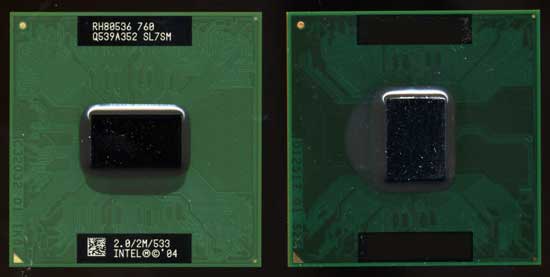
Dothan (Pentium M) on the left, Yonah (Core Duo) on the Right
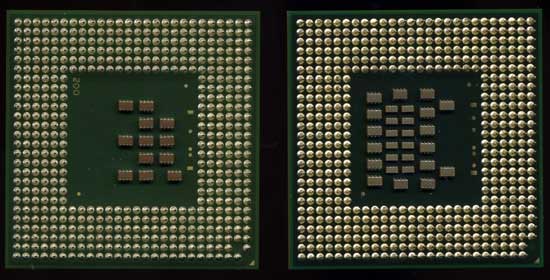
Dothan (Pentium M) on the left, Yonah (Core Duo) on the Right
A Fair Pentium M Comparison
Another issue that we had with the first article was that our comparison to the Pentium M was based on using an Intel 865 chipset; more specifically, using ASUS' CT-479 adapter and their P4P800-SE motherboard. While the motherboard itself performs quite well, we wanted a more even comparison between the Pentium M and the upcoming Core Duo processor.
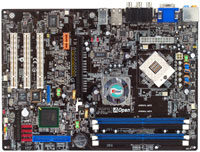 We turned to AOpen and they provided us with their i915Ga-HFS motherboard, based on Intel's mobile 915 express chipset with native support for the Pentium M processor. The biggest difference between our AOpen 915 platform and the 865 platform that we tested back in March? The 915 platform supports DDR2 memory, just like the 945 platform that we used with the Core Duo. Being able to use the exact same memory technology across both platforms removed yet another variable from our comparison, but frankly, it wasn't going to do much to the performance breakdown between the two chips.
We turned to AOpen and they provided us with their i915Ga-HFS motherboard, based on Intel's mobile 915 express chipset with native support for the Pentium M processor. The biggest difference between our AOpen 915 platform and the 865 platform that we tested back in March? The 915 platform supports DDR2 memory, just like the 945 platform that we used with the Core Duo. Being able to use the exact same memory technology across both platforms removed yet another variable from our comparison, but frankly, it wasn't going to do much to the performance breakdown between the two chips.
AOpen's board worked well during our testing, although we did have the occasional issue where the system would not POST. The issue wasn't readily repeatable, but it did happen a few times during our testing.
The only other quirk that we ran into with the AOpen board was the fact that it features absolutely no legacy ports on its I/O panel. There is support for a single PS/2 port that requires a separate bracket to be installed in your case (provided with the motherboard). Given the prevalence of USB keyboards and mice these days, it's not that big of an issue. We only mention it because the majority of our KVMs in-house are still PS/2 based.
We paired AOpen's 915 board with a Pentium M 760, which is based on the 90nm Dothan core running at 2.0GHz with a 533MHz FSB. So while the FSB speed is slower than the Core Duo that we're testing, the identical clock speed is helpful in a direct comparison between the two chips.
The Test
| CPU: | AMD Athlon 64 X2 4200+ (2.2GHz/512KBx2) AMD Athlon 64 X2 3800+ (2.0GHz/512KBx2) AMD Athlon 64 X2 2.0GHz/1MBx2 Intel Pentium M 760 (2.0GHz/2MB) Intel Core Duo T2500 (2.0GHz/2MB) |
| Motherboard: | ASUS A8N-SLI Deluxe AOpen i915Ga-HFS Unnamed 945G Yonah Motherboard |
| Motherboard BIOS: | ASUS: Version 1013 Dated 08/10/2005 AOpen: Version 1.11 Dated 11/15/2005 |
| Chipset: | NVIDIA nForce4 SLI Intel 915 Express Intel 945G |
| Chipset Drivers: | nForce4 6.66 Intel 7.0.0.25 |
| Memory: | OCZ PC3500 DDR 2-2-2-7 DDR2-533 4-4-4-12 |
| Video Card: | ATI Radeon X850 XT NVIDIA GeForce 7800GTX |
| Video Drivers: | ATI Catalyst 8.173.1.2 NVIDIA ForceWare 81.85 |
| Desktop Resolution: | 1280 x 1024 - 32-bit @ 60Hz |
| OS: | Windows XP Professional SP2 |
While we used an NVIDIA GeForce 7800 GTX for almost all of our tests, there was one exception, thanks to a NVIDIA driver bug. With dual core processors, NVIDIA's 81.95 drivers will cause the system to maintain 100% CPU utilization when running 3dsmax 7, even when the system is actually not doing anything at all. We didn't discover this bug until we had already run the majority of our tests using the 7800 GTX. So, for the 3dsmax 7 tests, we switched to an ATI Radeon X850 XT. The GPU doesn't impact CPU rendering performance at all, so it doesn't change the performance characteristics of the platform. We just wanted to point out the bug, in case any of you were wondering why your dual core platforms were behaving strangely in certain applications. NVIDIA is aware of the problem and is working on a publicly available fix.
For this comparison, we've kept the number of CPUs to a minimum, focusing on the Pentium M, Core Duo and Athlon 64 X2. The exclusion of the Pentium D was on purpose; we've already compared the Core Duo to the Pentium D in our last article and to put it bluntly, the Pentium D won't really be competition for any of Intel's new architectures. By this time next year, NetBurst will have already been forgotten and the real comparison that matters is how Core Duo stacks up to the Athlon 64 X2, whose architecture is not going the way of the dodo.
As we mentioned earlier in this article, in addition to the X2 3800+ and 4200+, we have included benchmarks of an Athlon 64 X2 running at 2.0GHz, but with a 1MB L2 cache per core (2MB total on die). The point of including this simulated "Athlon 64 X2 4000+" is to answer complaints that the Core Duo has a larger L2 cache than the X2 3800+ and thus isn't a true apples-to-apples comparison. So we've now leveled the playing field even more, and actually given AMD more of an advantage - the 2.0GHz/1MB L2 Athlon 64 X2 has a larger L1 cache (128KB per core vs. 64KB per core), and of course, the X2 still has its own on die memory controller.
With that said, let's see how things stack up now...
Overall System Performance with Winstone 2004
Business Winstone 2004
Business Winstone 2004 tests the following applications in various usage scenarios:
. Microsoft Access 2002
. Microsoft Excel 2002
. Microsoft FrontPage 2002
. Microsoft Outlook 2002
. Microsoft PowerPoint 2002
. Microsoft Project 2002
. Microsoft Word 2002
. Norton AntiVirus Professional Edition 2003
. WinZip 8.1

The FP/SSE enhancements to Core Duo have no chance to shine in your everyday run-of-the-mill business applications like Word and Outlook, not to mention that the workload is not heavily multithreaded, so there's no benefit from a dual core processor. So from a performance standpoint, all we see from the Core Duo is a similarly clocked processor to the Pentium M 760, but with a higher latency L2 cache, which explains the performance deficit.
The Athlon 64 X2 running at 2.0GHz with a 1MB L2 per core manages to slightly outperform the Core duo T2500, however the performance margin is negligible.
Multimedia Content Creation Winstone 2004
Multimedia Content Creation Winstone 2004 tests the following applications in various usage scenarios:
. Adobe® Photoshop® 7.0.1All chips were tested with Lightwave set to spawn 4 threads.
. Adobe® Premiere® 6.50
. Macromedia® Director MX 9.0
. Macromedia® Dreamweaver MX 6.1
. Microsoft® Windows MediaTM Encoder 9 Version 9.00.00.2980
. NewTek's LightWave® 3D 7.5b
. SteinbergTM WaveLabTM 4.0f

Not all of the Core Duo's advantage over the Pentium M is due to its dual core nature, but it does account for some of it.
But as we saw in our original article, at 2.0GHz, the Core Duo T2500 just isn't able to offer performance comparable to the Athlon 64 X2 at the same speed. It is worth noting that L2 cache size doesn't really make a difference here to the X2 at all, just clock speed. Thanks to the Athlon 64's on-die memory controller, the architecture is inherently less sensitive to cache size than more conventional designs that rely on an external memory controller.
Overall System Performance using SYSMark 2004
Office Productivity SYSMark 2004
SYSMark's Office Productivity suite consists of three tests, the first of which is the Communication test. The Communication test consists of the following:
"The user receives an email in Outlook 2002 that contains a collection of documents in a zip file. The user reviews his email and updates his calendar while VirusScan 7.0 scans the system. The corporate web site is viewed in Internet Explorer 6.0. Finally, Internet Explorer is used to look at samples of the web pages and documents created during the scenario."The next test is Document Creation performance:
"The user edits the document using Word 2002. He transcribes an audio file into a document using Dragon NaturallySpeaking 6. Once the document has all the necessary pieces in place, the user changes it into a portable format for easy and secure distribution using Acrobat 5.0.5. The user creates a marketing presentation in PowerPoint 2002 and adds elements to a slide show template."The final test in our Office Productivity suite is Data Analysis, which BAPCo describes as:
"The user opens a database using Access 2002 and runs some queries. A collection of documents are archived using WinZip 8.1. The queries' results are imported into a spreadsheet using Excel 2002 and are used to generate graphical charts."
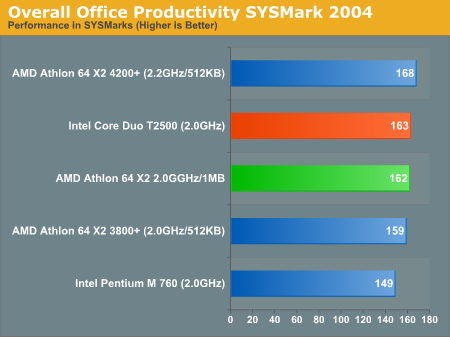
Compared to the Athlon 64 X2, the Core Duo T2500 manages to slightly outperform the X2 3800+, but moving to a larger cache helps the X2 narrow that already small gap. Even though the Core Duo has a one-point lead, given the percentage, we'd call this one a tie.
The breakdown of the Office Productivity SYSMark 2004 score is listed below, higher numbers mean better performance:
| OP SYSMark 2004 Score Breakdown | AMD Athlon 64 X2 4200+ | AMD Athlon 64 X2 3800+ | AMD Athlon 64 X2 2.0GHz/1MB | Intel Core Duo T2500 | Intel Pentium M 760 |
| Communication | 148 | 144 | 146 | 146 | 140 |
| Document Creation | 219 | 204 | 211 | 215 | 203 |
| Data Analysis | 145 | 136 | 138 | 138 | 117 |
ICC SYSMark 2004
The first category that we will deal with is 3D Content Creation. The tests that make up this benchmark are described below:
"The user renders a 3D model to a bitmap using 3ds max 5.1, while preparing web pages in Dreamweaver MX. Then the user renders a 3D animation in a vector graphics format."Next, we have 2D Content Creation performance:
"The user uses Premiere 6.5 to create a movie from several raw input movie cuts and sound cuts and starts exporting it. While waiting on this operation, the user imports the rendered image into Photoshop 7.01, modifies it and saves the results. Once the movie is assembled, the user edits it and creates special effects using After Effects 5.5."The Internet Content Creation suite is rounded up with a Web Publishing performance test:
"The user extracts content from an archive using WinZip 8.1. Meanwhile, he uses Flash MX to open the exported 3D vector graphics file. He modifies it by including other pictures and optimizes it for faster animation. The final movie with the special effects is then compressed using Windows Media Encoder 9 series in a format that can be broadcast over broadband Internet. The web site is given the final touches in Dreamweaver MX and the system is scanned by VirusScan 7.0."

The breakdown of the ICC SYSMark 2004 score is listed below, higher numbers mean better performance:
| ICC SYSMark 2004 Score Breakdown | AMD Athlon 64 X2 4200+ | AMD Athlon 64 X2 3800+ | AMD Athlon 64 X2 2.0GHz/1MB | Intel Core Duo T2500 | Intel Pentium M 760 |
| 3D Content Creation | 271 | 248 | 251 | 264 | 181 |
| 2D Content Creation | 340 | 312 | 314 | 323 | 238 |
| Web Publication | 274 | 254 | 257 | 236 | 162 |

Overall System Performance using WorldBench 5
Our final set of overall system performance tests come from WorldBench 5, which is a pretty good tool for looking at older application performance as well as single-threaded performance.
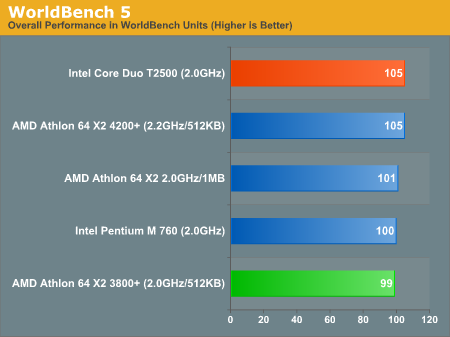
The breakdown of the WorldBench 5 score is reported below. Note that the values below are task completion times in seconds with lower numbers translating into better performance.
| AMD Athlon 64 X2 4200+ | AMD Athlon 64 X2 3800+ | AMD Athlon 64 X2 2.0GHz/1MB | Intel Core Duo T2500 | Intel Pentium M 760 | |
| ACD Systems ACDSee PowerPack 5.0 | 537 | 574 | 572 | 544 | 545 |
| Adobe Photoshop 7.0.1 | 339 | 364 | 362 | 319 | 325 |
| Adobe Premiere 6.5 | 388 | 402 | 400 | 405 | 404 |
| Ahead Software Nero Express 6.0.0.3 | 507 | 509 | 506 | 512 | 510 |
| Discreet 3ds max 5.1 (DirectX) | 254 | 268 | 266 | 256 | 256 |
| Discreet 3ds max 5.1 (OpenGL) | 317 | 337 | 333 | 320 | 322 |
| Microsoft Office XP with SP-2 | 524 | 531 | 536 | 531 | 505 |
| Microsoft Windows Media Encoder 9.0 | 283 | 304 | 301 | 295 | 415 |
| Mozilla 1.4 | 360 | 440 | 411 | 338 | 310 |
| Multitasking: Mozilla and Windows Media Encoder | 445 | 484 | 445 | 439 | 634 |
| MusicMatch Jukebox 7.10 | 483 | 527 | 531 | 511 | 529 |
| Roxio VideoWave Movie Creator 1.5 | 262 | 278 | 277 | 267 | 400 |
| WinZip Computing WinZip 8.1 | 401 | 420 | 419 | 396 | 399 |
Professional Application Performance with 3dsmax, Adobe Premier and Photoshop
We start off our page on professional application performance with an updated version of the SPECapc 3dsmax test, updated for version 7 of the application. The scenes being rendered haven't actually changed, but the reference numbers used to compute the composite scores have, so these scores aren't directly comparable to results from earlier SPECapc tests.
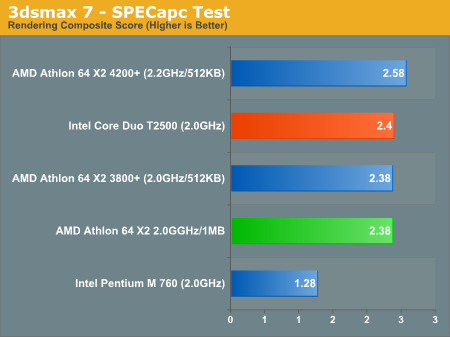
Compared to the Athlon 64 X2, the Core Duo comes out on top, but by a very small margin - once again we're faced with a virtual tie.
The breakdown of the rendering composite score can be found below; the scores in the table are render time in seconds, lower numbers are better:
| SPECapc 3dsmax 7 Breakdown | AMD Athlon 64 X2 4200+ | AMD Athlon 64 X2 3800+ | AMD Athlon 64 X2 2.0GHz/1MB | Intel Core Duo T2500 | Intel Pentium M 760 |
| 3dsmax 5 rays | 15.406 | 15.829 | 16.109 | 14.297 | 25.246 |
| CBALLS2 | 20.125 | 22.281 | 22.094 | 21.187 | 42.201 |
| SinglePipe2 | 92.844 | 101.906 | 101.922 | 107.359 | 203.492 |
| UnderWater | 142.938 | 157.219 | 156.203 | 169.188 | 316.055 |
Moving onto Adobe Premier Pro 1.5, this test is actually one that is used by Intel to showcase the performance of the Pentium 4 processor. With the Pentium 4 absent from this comparison, we were curious as to how it compared to the Core Duo and the Pentium M.
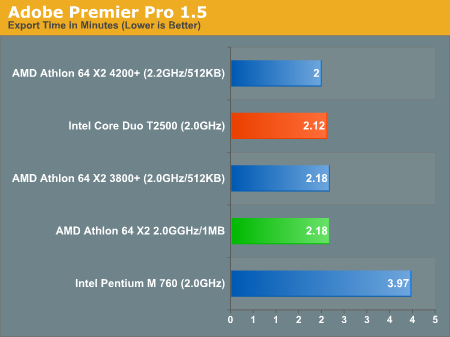
As with virtually any media encoding performance, dual-core processors do extremely well, and this case is no different with the Core Duo T2500 seriously outpacing the Pentium M 760.
The Core Duo T2500 is also able to complete the export process in about 97% of the time of the Athlon 64 X2, which once again ends up being borderline negligible for this test, but it is important to note that this advantage comes without the aid of an on-die memory controller.
Our final test is the only other Intel-supplied test in the suite. This one used to showcase the Pentium 4's performance under Adobe Photoshop CS2 by measuring the time that it takes to run a few filters and resize/export images. The script itself is fairly realistic; however, with Photoshop filters, it is easy to favor one architecture over another, so by no means are these numbers intended to be conclusive of Photoshop CS2 performance.
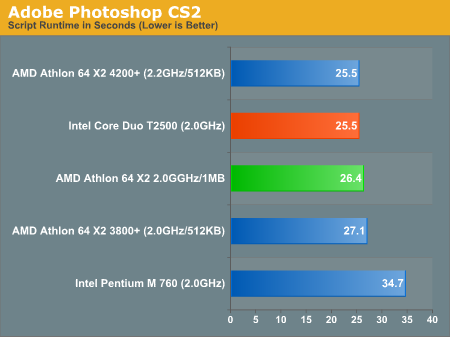
Media Encoding Performance with DVD Shrink, WME, Quicktime and iTunes
We were most curious about the Core Duo's media encoding performance, given that a number of the optimizations for the new processor were FP/SSE related. We've updated our entire media encoding test suite, including everything from the one-click DVD ripping utility DVD Shrink to including H.264 encoding performance with Quicktime 7.0.3 Pro. We wanted to include the latest version of DivX in this comparison. However, the recent release of DivX 6.1 left us with a few bugs that we're still trying to work out in our test beds, so we had to exclude it. However, as time goes on, H.264 encoding will quickly become far more important than even looking at DivX, so its omission from this article isn't as big of a loss in terms of forward-looking performance.
First up is DVD Shrink 3.2.0.15. Our test was simple - we took a copy of Star Wars Episode VI and ripped the full DVD to the hard drive without compression, effectively giving us an exact copy of the disc on the hard drive. Then, using the copy of the DVD on the hard drive (to eliminate any DVD drive bottlenecks), we performed a DVD shrink operation to shrink the movie to fit on a single 4.5GB DVD disc. All of the options were left on their defaults, so the test ends up being pretty easy to run and reproduce. The scores reported are DVD encoding times in minutes, with lower numbers meaning better performance.
The DVD Shrink test is quite important as DVD Shrink is quite possibly one of the easiest tools to rip a DVD. The easier a tool is to use, the more likely it's going to be used, and arguably the more important performance using it happens to be.

- The Pentium M performs exceptionally poorly, and
- The Core Duo performs exceptionally well.
Moving on, we have our Windows Media Encoder 9 test, which uses the advanced profile settings for video encoding. We left all settings at their defaults and just proceeded with a MPEG-2 to WMV-HD conversion. The values reported are in frames per second, with higher numbers being better.
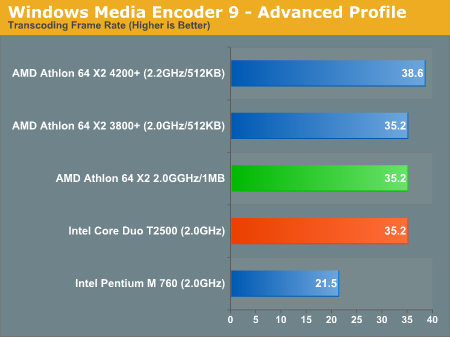
Next up, we have Quicktime Pro 7.0.3 and we perform a MPEG-2 to H.264 encoding task. All of the settings are left at their defaults, with the exception that we optimize the output file for download with a 256kbps data rate while leaving the resolution untouched. We also adjust the video options to optimize for the best quality. We report the transcoding time in minutes, with lower values being better.
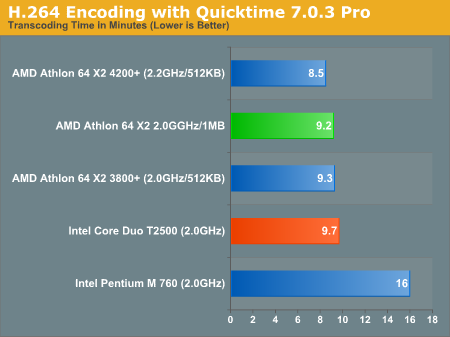
Finally, we have a MP3 encoding test using iTunes 6.0.1.3. For this test, we simply took a 304MB wav file and converted it to a 192kbps MP3 file, measuring the encode time in seconds. The only iTunes option that we changed was to prevent the playback of the song while encoding.
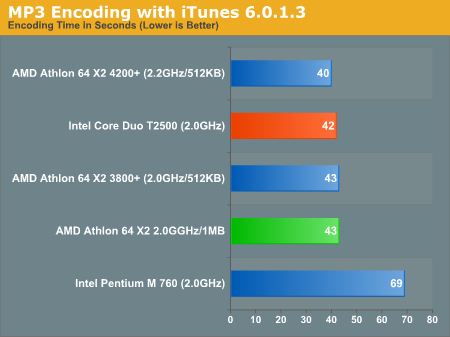
Gaming Performance with Battlefield 2 and Black & White 2
The gaming performance of the Core Duo is not as cut and dry with respect to the Pentium M as some of the other performance tests, mainly because the vast majority of games are still single threaded. Here, we have to rely on the FP/SSE optimizations in games to overwhelm the increase in cache latency to give the Core Duo any sort of advantage over the Pentium M.
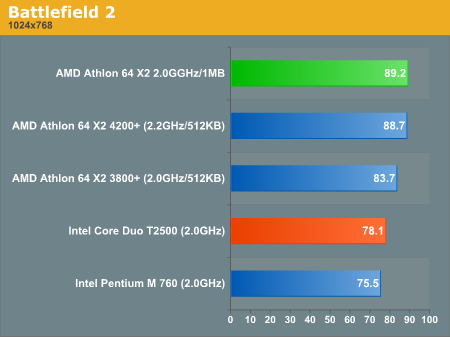
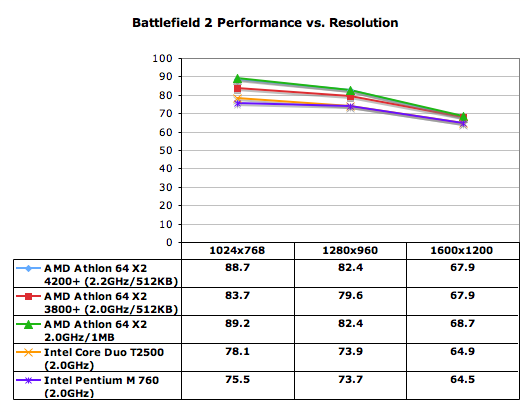
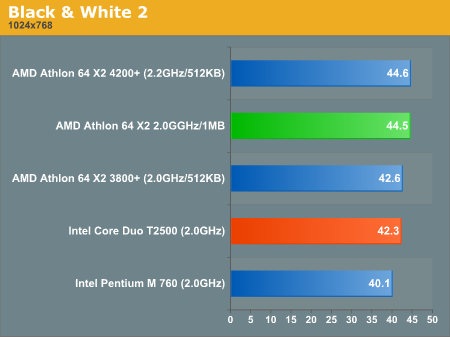
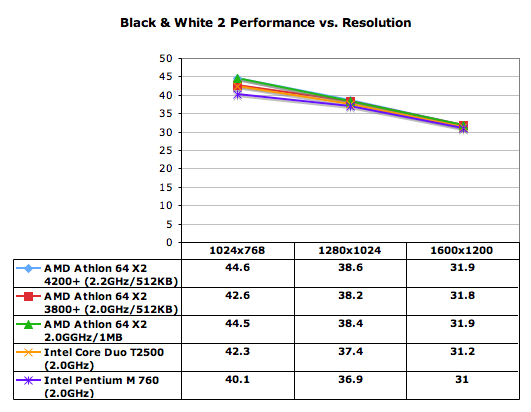
Gaming Performance with Call of Duty 2 and F.E.A.R.
Both CoD2 and F.E.A.R. appear to be GPU bound, even at 1024 x 768 with a GeForce 7800 GTX, so the performance of all of the processors is virtually identical. It is worth noting that CoD2 is one situation where the Pentium M is actually slightly faster than the Core Duo; once again, most likely do to its lower latency L2 cache.


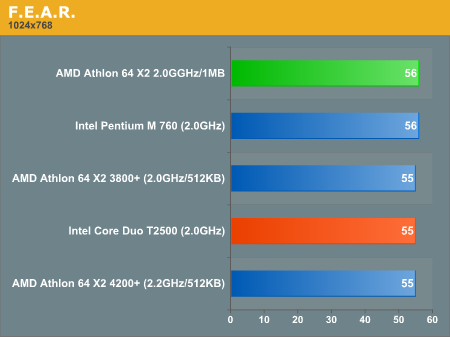

Gaming Performance with Splinter Cell: CT and Quake 4
While Splinter Cell doesn't show any performance differences between the offerings, we do see a bit of a breakdown with Quake 4. Here, the Core Duo T2500 presents a 12% increase in performance (note that this is without the recent dual-core Quake 4 patch) over the Pentium M 760, but still trails behind the Athlon 64 X2.
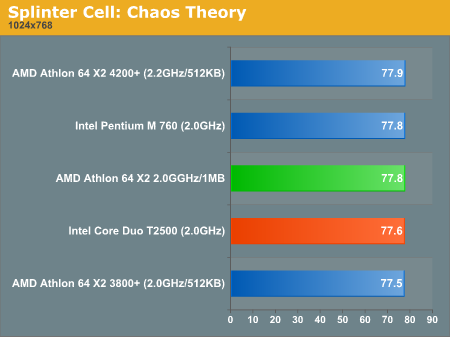
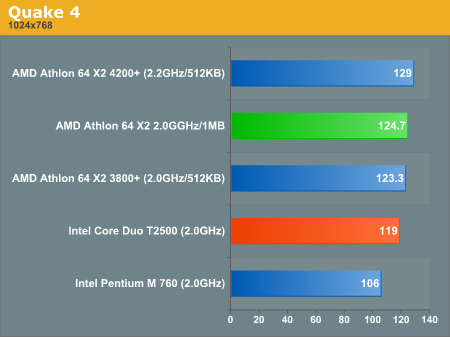
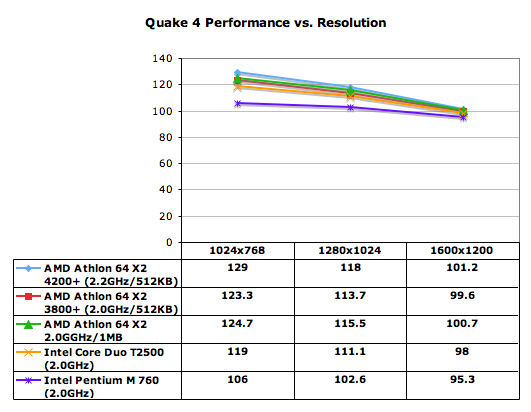
Final Words
With updated benchmarks and a more level playing field comparison to the Pentium M and Athlon 64 X2, we're truly able to see the potential of Intel's Core Duo processor. Our initial analysis still holds true, that for a notebook processor, the Core Duo will be nothing short of amazing for professionals. Looking at the performance improvements offered everywhere from media encoding to 3D rendering, you're going to be able to do a lot more on your notebook than you originally thought possible (without resorting to a 12-pound desktop replacement). In the past, power users on the go had to sacrifice mobility for CPU power, but with the Core Duo, that is no longer the case. You will still most likely have to resort to something larger if you need better GPU performance, but at least your CPU needs will be covered. The one thing that Intel's Core Duo seems to be able to do very well is to truly bridge the gap between mobile and desktop performance, at least in thin and light packages.
But what about the bigger picture? What does our most recent look at the performance of Intel's Core Duo tell us about future Intel desktop performance? We continue to see that the Core Duo can offer, clock for clock, overall performance identical to that of AMD's Athlon 64 X2 - without the use of an on-die memory controller. The only remaining exception at this point appears to be 3D games, where the Athlon 64 X2 continues to do quite well, most likely due to its on-die memory controller.
The problem with the Core Duo is that its clock speeds aren't going to be quite high enough to be competitive, on the very high end, with AMD. Luckily for Intel, Conroe should be able to offer higher clock speeds without much of a performance penalty, thanks to its 4-issue core. It is always interesting to note that Intel's marketing focus is moving away from focusing on ILP (Instruction Level Parallelism), yet one of its biggest features of their next-generation microarchitecture is a significant increase in ILP.
Honestly, as it stands today, if Intel can get clock speeds up, the only area that they will need to improve on is gaming performance to be competitive with AMD. We wouldn't be too surprised if the comparisons that we have shown today end up being very similar to what we encounter at Conroe's launch: with AMD and Intel performing very similarly at the same clock speeds, but with AMD's on-die memory controller giving it the advantage in gaming.
Intel's Core Duo launches in January at CES, so if you've been thinking about buying a new laptop, we'd suggest waiting at least another month or so. You won't be disappointed.







